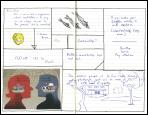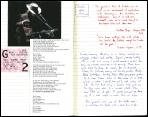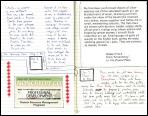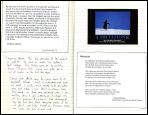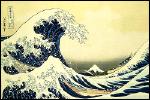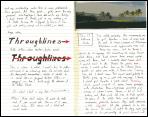This is the most recent in a long line of pen-and-ink drawings I have done over the last fifteen or twenty years. I have a particular way of working that has evolved over time. Most of the drawings are done on Bristol paper, which has a very smooth surface that accepts a clean line, and doesn't tear up the tips of the Pigma Micron pens (usually .05 or .08) that I like because the ink dries quickly and is waterproof.
I find the process of drawing to be enjoyable, a way of centering myself. I most often listen to music, humming or singing along to myself while I am drawing. I begin by penciling in the rectangle that I'm going to work within. I used to do the drawing first and add the surrounding rectangle, afterwards, but discovered that it is prohibitively expensive to pay for mats and frames in custom sizes, so in recent years I pick a standard-sized mat, measure out the opening in the mat, and then draw very lightly in pencil the lines that will form the outer edges of the finished drawings.
I never have a plan laid out in advance when I draw, I just put the tip of the pen down on the paper and draw some kind of shape and fill it in, then do another next to that, and another next to that. I leave white space between each shape, and as I work the white space, the negative space, starts to assert itself as a compositional focus that often outweighs the shapes I have actually drawn. At some point I will draw straight lines, like the diagonals in the picture above, to subdivide the paper into sections. In terms of composition, my goal is to wind up with a some stylistic consistency within each section and stylistic variety from section to section. (In an earlier post I wrote a poem about how this process works.)
Obviously this drawing is not a literal representation of anything to be found it the world. It's more or less a pure abstraction, although inevitably some abstracted elements will wind up suggesting something to whoever looks at the drawing. While it's not unusual for people to tell me when they "see" something in the drawing, it is very unusual for that something to be anything I had consciously included. An example in this case is the small rectangular shape in the middle right of the picture which reads as perhaps a house or a face sitting atop something that might be read as a star. I find it interesting when those elements make their presence known as I draw, but I can't say that I have planned them. I accept them as pleasant surprises, or as evidence of my subconscious tossing up something I was not expecting and will not immediately—or perhaps ever—understand. Even the large flowery shape at the upper left emerged mostly because I was working to fill in the negative spaces left by the sixteen smaller shapes surrounding it. I was also consciously trying to introduce some semitones in the form of dots and thin lines to contrast with the more heavily contrasted black and white sections in the rest of the drawing. It became a plant form only by default.
I've had a lifelong interest in art, and have a large collection of books related to drawing and painting and collage. One of the things that satisfies me about the work that I have been doing is that there is nothing like it out there anywhere. There's some Zentangle stuff that I took an interest in for a while, but most of what I saw out there seemed to me to be over-structured and stylistically repetitive. This art is my art. Each time I sit down to draw it's an adventure of sorts, a process of exploration and observation. I enjoy making the drawing, and I enjoy studying the resulting artwork once it is made.
These kinds of drawings do not lend themselves to explanation. There's not much that I or anyone else could offer by way of paraphrase or summary. I could describe in words what goes on in my head when looking at any one section, or at the drawing as a whole, but that would be a pretty pointless exercise. They exist in a non-verbal plane.
Which is not to say that there are no parallels between what I am doing when I draw and what I am doing when I write poetry, or prose, for that matter. My writing practice is not unlike my drawing practice. Probably the most simple and elegant articulation of that process, whether working as an artist or as a writer, has been attributed to Jasper Johns: Do something. Then do something to that. Then do something to that.
I'm sure that there are some people, and you, Gentle Reader, may very well be one of them, who would question why any sane person, given the ongoing political and environmental chaos going on in the world and getting worse every day, would choose to spend his time producing hermetical drawings or often well-nigh incomprehensible poems. My response is pretty simple. There is little or nothing I can do at the personal level to deal with any of that stuff. I'm an old man. I do not see any reason to choose to spend the limited amount of time I have left on this planet tilting at windmills. My art, and my poetry, is something that gives me pleasure while I do it, and some small measure of satisfaction when it is done. Granted, the value that accrues from it does not have a positive impact on the world as it is. But it helps me to navigate and endure that world, for as long as I remain a part of it.
I'll bookend this post with the followup drawing I completed yesterday:


